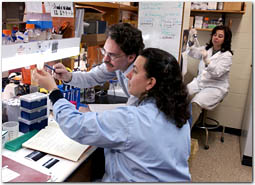 |
Science Highlights > Genomic Studies
Genomic Studies
 |

Click to enlarge
|
|
Research Associate Sibel Karchner, foreground, and Associate Scientist Mark Hahn examine bacterial colonies used to clone fish genes that play a role in determining susceptibility to toxic chemicals. Senior Research Assistant Diana Franks, right, prepares samples for DNA sequencing. (Photo by Tom Kleindinst) |
An architect’s blueprints offer keen insights into how a building is constructed and how it works. Similarly, an organism’s genome—the total of all the genes in its DNA—holds clues to how that organism functions in its environment, adapts to change, and evolves over time.
To unveil new layers of understanding about marine life, WHOI biologists are exploiting technological and scientific advances in the field of genomics—the systematic analysis of the structure, variation, evolution, and function of genes and the myriad of life-sustaining proteins they produce.
Associate Scientist Mark Hahn and Senior Scientist John Stegeman are leading investigations of the genetic mechanisms by which marine organisms detect, respond to, and adapt to environmental changes, especially the introduction of toxic chemicals. Such research may shed light on the ability of living things to respond or adapt to the influence of toxins, such as carcinogenic pollutants.
Senior Scientist Don Anderson and Research Associate Deana Erdner are using a recently developed genetic technique to identify the toxin-producing genes in marine microbes that produce harmful algal blooms. This will give scientists the ability to create molecular “tags” to identify contaminated shellfish more easily.
Assistant Scientist Tim Shank employs genomics to help answer questions about organisms living around hydrothermal vents. He is probing the genetic machinery that has allowed organisms to thrive in a hostile environment where there is no light, pressure is 250 times what we experience at the surface, and vent plumes contain high concentrations of metals at 660° to 750° F (350° to 400° C).
Genomics has become a component of much of the work underway in the Biology Department. About half of the department’s 27 Scientific Staff members are involved at some level in genomics-based studies of marine life. As a key tool to understanding the structure and function of life, its role is expected to grow in reach and influence.
|
